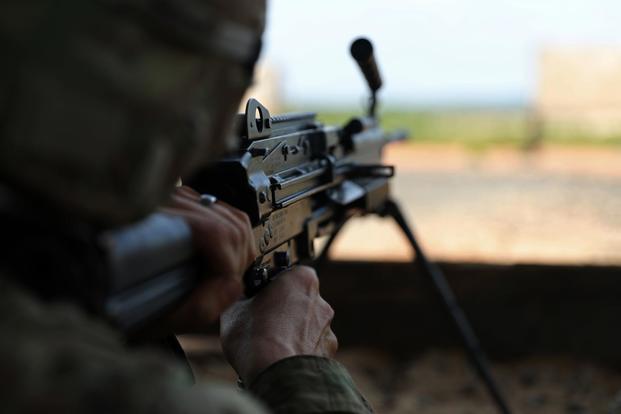The Army general in charge of modernizing soldier lethality said recently he is confident that the service will begin replacing both M249 squad automatic weapons and the M4 carbines in infantry brigades in 2023.
Army testers are currently shooting the first 6.8mm rounds through a variety of rifle and automatic rifle prototypes of the Next Generation Squad Weapon (NGSW) at Aberdeen Proving Ground, Maryland, Brig. Gen. David Hodne told Military.com at a June 16 Army Futures Command media event.
The service's goal is to select a final design for both weapons from a single provider in the first quarter of 2022 and begin replacing M4s and M249s in an infantry brigade combat team (IBCT) in the first quarter of 2023, said Hodne, director of the Army's Soldier Lethality Cross Functional Team.
"We are going to do both," he said, explaining the Army won't be sure how long it will take to equip that first IBCT until it can evaluate the winner's production capability.
Related: Acting Army Secretary Shoots Early Version of Next-Gen Squad Weapon
"The first unit equipped spans a period of months, and that first unit equipped will include both [weapons]," Hodne said.
The NGSW effort is part of the modernization strategy being orchestrated by Army Futures Command (AFC). Based in Austin, Texas, the command will reach full operating capability as of July 31, AFC Commander Gen. Mike Murray told reporters at the event.
Both the NGSW carbine and automatic rifle are being designed to fire a special, government-designed 6.8mm projectile that Army leaders say will penetrate modern enemy body armor at greater distances than the current M855A1 5.56mm Enhanced Performance Round.
The Army intends to conduct live-fire tests on NGSW prototypes from several gun makers until August, when it is scheduled to select up to three vendors that will move to the next phase of testing, Hodne said.
The August down-select will involve the companies that participated in the Army's second prototyping opportunity notice (PON), released in January, that directed gun makers to develop prototypes of both the rifle and auto rifle versions of the NGSW to ensure both work with the common 6.8mm projectile.
Army officials would not release the names of the companies chosen to make prototypes for the second PON effort.
Last July, the service awarded contracts for the first PON effort to several companies, but that effort involved only prototypes for the automatic rifle version of the NGSW.
"We learned a lot in this process. ... Industry took a very hard problem, and they have developed some very innovative solutions," Hodne said. "The first prototyping opportunity notice was centered around an automatic rifle. What we learned was -- to get the best rifle and the best automatic rifle -- we realized the approach had to be centered around a common cartridge that was supportable by both systems."
The Army left it up to vendors to design the type of 6.8mm cartridge they wanted to use in their prototypes, Hodne said, adding that some gun makers went with "traditional bottleneck" brass cartridges while others used newer, case-telescoped cartridges.
Another part of the NGSW effort is the advanced fire control system, which is being designed to calculate range to target, atmospheric conditions, and the ballistics of both weapon and ammunition, according to the May 30 prototype opportunity notice.
The Army expects to receive fire-control prototypes sometime in October, according to Brig. Gen. Anthony Potts, commander of Program Executive Office Soldier.
"People as, 'Is the technology going to be there?' " Potts said. "The answer is yes. ... I am very enthused about next generation squad weapon ... it's not just an evolution in capability. It's a revolution in capability. It really will change the lethality of our squads."
-- Matthew Cox can be reached at matthew.cox@military.com.












